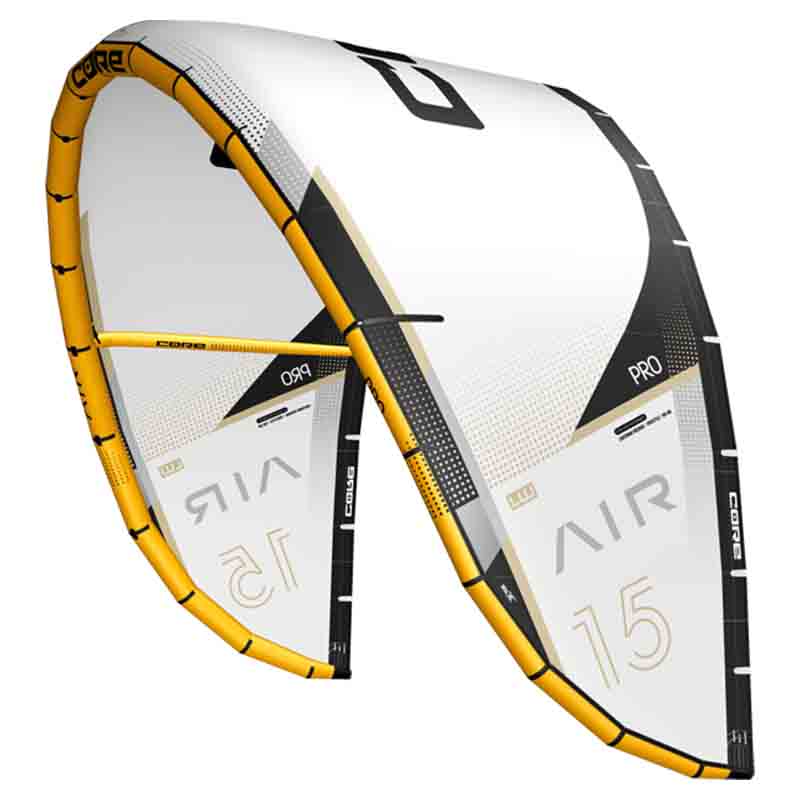When you purchase gear through links on our site, we may earn a small commission. Here’s why you can trust our tests and our affiliate partner.

Traditionally, each of the CORE kite model ranges had a LW edition in the larger sizes, which used revised materials and shape to optimize the low end to the existing model line and still have a uniform feeling, retaining some of the character of the standard models.
Recently the Pace has been a runaway success for Fehmarn’s finest. The modern 3-strut platform covers a multitude of riding situations and covers a massive range of abilities and conditions, and is now available in both Dacron and Aluula versions. It makes perfect sense to take this versatile platform for an all-new lightwind-specific model in the form of the Air and Air Pro, which both come in 15m and 17m sizes and will stand as a model range in its own right.
We’re going to focus on the Air Pro as this was quite the revelation at the Cape Town meeting this year, with universal praise on those lightwind mornings. CORE have pulled out all the stops in terms of materials, and it’s an unashamedly high-end machine. It’s a full Aluula airframe with a CoreTex 2 canopy. The coating feels extremely glossy and proves to be very water repellent. An eye has definitely been kept on weight saving.
From a shape perspective with a casual eye, it looks like a Pace that’s been elongated. They’ve been able to shrink the tube diameters by using Aluula, making it look lean and purposeful. This also allows for some twist in the airframe to increase agility. The Tectanium bridling is pulley-less and fixed for ultra direct steering inputs and responsiveness. It also means you need to be using the CORE Sensor 4 or Sensor 4 Pro bar to get it to flag out correctly. Something the crude eye wouldn’t notice is that the kite’s profile has been optimized for light wind. There’s plenty of camber in there to give that positive grunt. Aspect ratio has also been ramped up, with extended wingtips giving plenty of leverage to initiate that all important twist in the frame to liven up a kite with plenty of surface area.
What was most remarkable about the Air Pro was the sheer amount of lift and power available in such meager and wafty conditions. Basically, if the kite will fly and climb positively you can ride. For a kite of this magnitude and power potential, the steering is ultra crisp and responsive; you can see the whole kite twist when you initiate assertive bar inputs and the Aluula reflex bounces back to shape when you straighten up. Part of the Air Pro’s magic in terms of usability is how well it climbs for a large canopy. It always wants to push forwards. Sheeting has a dramatic effect on power delivery, it’s got bags of low-end torque and linear power control over a relatively short bar stroke. It’s a much lauded statement historically, but it genuinely feels like a smaller kite in terms of turning speed. I’ve used much slower 12m freeride kites, albeit in Dacron.
Looping a 15m kite and it whipping round in a nimble fashion with a smooth power surge and then also having a decent degree of catch shouldn’t really be possible, but with cutting edge materials and a well-honed shape CORE seem to have defied the rules of physics in this instance. For learning Big Air tricks in lighter wind conditions this could well be a gamechanger, as with that much loft and hangtime on tap you have plenty of time to spin around and take your board off or perform whatever you please. Crucially, the control is there to dictate how high you’re going to go and really throttle your descent as well. Heli-looping a 15m is now very much on the table.
As a lightwind freeride kite this is as good as it gets; long gone are the days of tractoring around and mowing the lawn in lower wind speeds. Both the agility and easy-to-access power of the Air Pro really set it apart from the pack in terms of pure fun and application.
